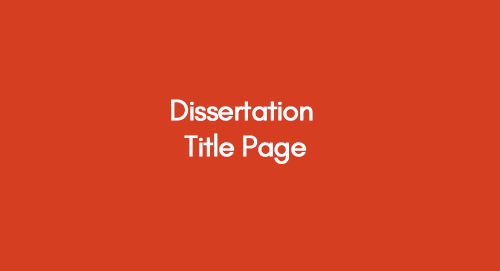
How to Create Dissertation Title Page: A Beginner’s Guide
June 1, 2023
What is English Literature Dissertation? | Examples & Tips
June 2, 2023Want to create an artistic dissertation layout because attention to detail will wow the reader. A dissertation layout is a monumental task that requires careful planning, rigorous research, and insightful analysis.
Review Our Quality Dissertation Example
Review Our Prime Dissertation Topics
Creating the layout of your professional dissertation before you begin can help you achieve your objectives. However, the importance of an effective dissertation layout is often overlooked by many students. A well-structured layout not only enhances the readability of your work but also helps convey your ideas in a coherent and organized manner.
Example 1: Creating an Outline: A Step-by-Step Guide on How to Write an Outline?
Example 2: An Effective Abstract : How to Write an Abstract for a Research Paper?
Note: Below is a complete guide with some more examples and tips for you to ace the skill of dissertation writing.
Get 3+ Free Custom Topics within 24 hours;
Understanding the Dissertation Layout Template
Before diving into the intricacies of the layout, it's important to have a clear understanding of the overall structure of a dissertation.
How to Write an Academic Report: A Guide for Students
While specific requirements may vary depending on your institution and field of study, one of the dissertations layout examples mentioned below typically follow a common framework:
While the specific layout of a dissertation can vary depending on institutional guidelines and disciplinary conventions, here are some common examples of dissertation layout components:
[Title Page]
Title of the dissertation
Author's name
Degree program or department
Institution
Date of submission
[Abstract]
A concise summary of the dissertation, including research objectives, methodology, key findings, and conclusions. Usually limited to a specific word count.
[Table of Contents]
A list of chapters, sections, subsections, and their corresponding page numbers. Provides an overview of the structure of the dissertation for easy navigation.
[List of Figures/Tables/Abbreviations]
If applicable, separate lists to provide a clear reference to all figures, tables, or abbreviations used in the dissertation.
[Introduction]
Sets the context for the research, outlines the research objectives and questions, and provides an overview of the dissertation structure.
[Literature Review]
A comprehensive review of relevant literature, theories, and previous research related to the research topic. Presents a synthesis of existing knowledge and identifies research gaps.
[Methodology]
Describes the research design, data collection methods, and analytical techniques used in the study. Provides sufficient details to allow replication of the research.
[Results]
Presents the findings of the research, often including tables, figures, or other visual representations of the data. The results should be clearly organized and aligned with the research questions.
[Discussion]
Interprets and discusses the findings in relation to the research questions, existing literature, and theoretical framework. Analyzes the implications, limitations, and potential future directions of the research.
[Conclusion]
Summarizes the main findings of the study, addresses the research objectives and questions, and provides a reflection on the significance of the research.
[References]
A comprehensive list of all the sources cited in the dissertation, following a specific citation style (e.g., APA, MLA, Harvard).
[Appendices]
Additional material that supports the main text, such as raw data, interview transcripts, questionnaires, or detailed descriptions of methods or calculations.
It is important to note that these examples serve as a general academic guideline, and it is essential to consult your institution's specific guidelines and any discipline-specific requirements when formatting your dissertation layout.
Tips for Crafting a Dissertation Layout
If you are planning to design the most professional thesis layout, you can’t ignore most of the relevant points. Those require a careful balance of content, structure, and style. The layout of your dissertation should be clear, concise, and easy to follow. It should also be visually appealing and engaging.
How to Write an Academic Report: A Comprehensive Guide
Here are some tips for creating a well-designed dissertation layout:
- In your dissertation, stick to the same font and size. This will make your dissertation seem more cohesive and make it simpler to read.
- To organize your writing and make it simpler for your reader to discover the information they need, use headings and subheadings. The headings should be informative, succinct, and clear.
- Use white space to create a sense of balance and make your dissertation easier to read. Don't be afraid to leave some blank space on the page.
- Use tables, figures, and other visuals to illustrate your points and make your dissertation more visually appealing. Visuals should be clear, concise, and easy to understand.
- Use a consistent style throughout your dissertation. This includes things like the use of citations, abbreviations, and punctuation.
How to Structure Your Dissertation for Optimum Impact?
The layout of your dissertation is an important part of the overall presentation of your work. By following these tips, you can create a dissertation that is both visually appealing and easy to read.
Conclusion
A well-structured layout not only enhances the readability and organization of your work but also demonstrates your attention to detail and professionalism. In this comprehensive guide, we have explored the essential components of a dissertation layout and provided valuable tips to help you excel in this aspect of academic writing.
By understanding the overall structure of a dissertation, you can create a cohesive and coherent document that effectively communicates your research findings and contributes to the academic discourse in your field.
FAQs
What is the importance of dissertation layout?
Dissertation layout is important because it can make your dissertation easier to read and understand. A well-designed dissertation layout will help your reader to find the information they are looking for quickly and easily. It will also make your dissertation look more professional and polished.
What are some common mistakes to avoid when creating a dissertation layout?
- Using many different fonts or font sizes.
- Not using headings and subheadings.
- Not using white space.
- Not using tables, figures, and other visuals.
- Not using a consistent style throughout your dissertation.
How can I get feedback on my dissertation layout?
Once you have created a draft of your dissertation layout, it is important to get feedback from others. Here are a few suggestions:
- Ask your advisor or dissertation committee to review your layout.
- Use online academic support services. These services can provide you with feedback on your layout and help you to improve it.
Get an Immediate Response
Discuss your custom requirements with our writers
Free Online Plagiarism Checker For Students
We will email you the report within 24 hours.
Upload your file for free plagiarism


























